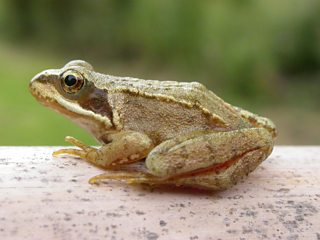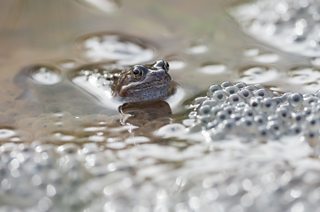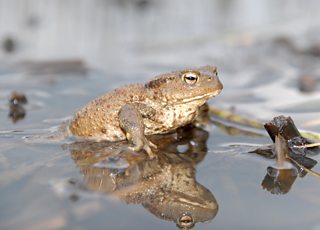By Kate Dawson, Content Manager at the Wildfowl & Wetlands Trust (WWT)
You might assume that any pond will attract amphibians, but there are a few things you can do if you want to give them the best chance at survival. With , it’s more important than ever to give them the wetland habitat they need to live and reproduce.

A frog out of water? Photo by James Lees/WWT
How can amphibians find and access my pond?
To help amphibians reach your pond, consider making your garden less tidy! Open spaces are not great for small amphibians trying to evade the attention of predators, so see if you can create areas of shelter with logs or longer grass. If there’s an obvious way into your garden, you could create amphibian rest stops along the way.
When building your pond, make sure the margins are reasonably broad and shallow – this will allow easy access for the animals, encourage stronger plant growth and provide warmer areas of water, which will speed up the development of tadpoles. If there is a raised edge, you can add in natural ‘steps’ with stones and logs to help the little creatures in and out.
Can I add frogs to my pond?
Don’t transport clumps of frogspawn from another pond into your own, no matter how tempting it might be to have little froggy residents! This can spread lethal amphibian diseases like Chytrid fungus and invasive species. Frogs, newts and toads are really good at finding suitable habitat, so try and be patient and they will hopefully find you. Toads may disperse up to 2km from their breeding pond to find new sites.

Build it and they will come... Photo by Nigel Snell/WWT
What plants do amphibians like?
A mix of marginal and floating pond plants are a great choice as this provides shelter for frogs, toads and newts. Newts lay their eggs in spring to summer and need rafting pond plants with small leaves, as the female will lay her eggs on the underside of a submerged leaf and wrap the egg up in it.
Great crested newts are larger and like lots of cover from floating pondweed, but they also need open space in the middle of the pond to perform their elaborate courtship dance in the spring.
Non-native plant species are not a friend to amphibians as our native frogs and toads are not adapted to deal with them, and they might end up outcompeting native plant species and causing problems. Native plants are also more likely to attract native pollinators and other insect life, which provides food for amphibians.

A frog floats among the vegetation. Photo by John Doherty/WWT
When should I build my pond?
Spring or summer are great times to build a pond in your garden, because it allows time for it to settle before early spring when amphibians will be spawning.
What size should my pond be?
It’s a myth that only large ponds will attract amphibians. The main thing is to allow enough space for shallow water areas around the edge of the pond. This is so that marginal plants can grow, and amphibians will have a safe place to breed in spring. If you don’t have a regular water source, it’s better to go for a single basin in your pond as if you have many shallow depressions, tadpoles might get stuck and dry out if you get a period of hot weather in the summer. You also don’t want your pond to freeze solid in the winter, as amphibians hibernate at the bottom.
The common toad does enjoy a larger sized pond (20m² would be ideal) so a little one is less likely to attract this species, but it’s definitely not a certainty - and besides, frogs and newts are not so fussy and will be happy in a smaller pond. That being said, the smaller the pond the more important it is that any spawn is not predated. Which brings us on to...

A majestic toad, reflected on the surface of a pond. Photo by James Lees/WWT
Should I add fish to my pond?
Many people like to add fish such as goldfish and koi carp but – be warned - they will gobble up many of the other creatures that make garden ponds so fascinating and usually need to be given additional food, which adds a lot of extra nutrients to the pond. Fish are particularly problematic in smaller ponds. For that reason it’s a good idea to create a pond that’s filled by rainwater, not connected to a stream, as this will lessen the chance of fish entering the pond.
If you really want to add fish, then small, native fish such as sticklebacks and minnows are your best bet as they are a natural fit with the British pond ecosystem. Although sticklebacks are carnivorous and will predate on insect larvae and tadpoles, if your pond is fairly sizeable they shouldn’t be too problematic for resident amphibians. However, if you really want to prioritise your pond as a habitat for amphibians, fish of any kind are not recommended.
The main thing to know about ponds is...
You don’t need to have a huge garden to add a valuable water source. Find out more about bringing water to your garden and creating a haven for amphibians and all sorts of wildlife with .
are the UK’s leading wetland conservation charity, protecting, restoring and creating wetlands for wildlife and people.
